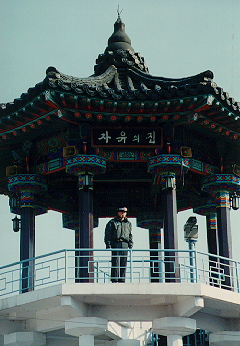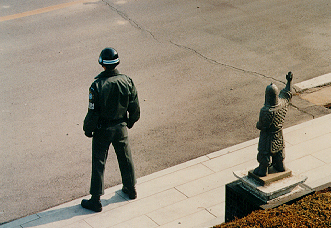Our next big outing was to the DMZ (Demilitarized Zone) that separates
North from South Korea. We went on a tour given by the USO (more
English-speakers!! yay!!). The Zone is about an hour north of Seoul.
(and North Korea's capital, Pyongyang, is about and hour north from the DMZ,
too.)
The tour got off to a nerve-wracking start. We had to be 'briefed'
by the military as to what to expect during our trip through the DMZ...
what not to do when we saw North Korean soldiers (no
pointing, no uttering of anything that could be construed as
propaganda...). It was during this briefing that we were asked to
sign a declaration that essentially waives
the UN's responsibility of us once we enter the DMZ.
We signed this after we heard the story of the attack on a US soldier by
20 North Korean troops several years ago. The US soldier was on a
routine tree-trimming mission, when these North Korean soldiers stormed
across the line and hacked him to death with axes. In the picture below,
the tree at the bottom (slightly towards the left) is encased in cement.
It looks different than the other trees along this road. This is the
tree in question, and the cement encasement is a memorial to mark the
death of that US soldier.
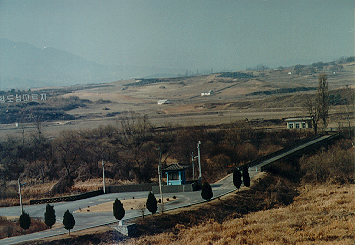
the DMZ
The 'close' side is the South, while the barren-looking 'far side' is the
North.
Notice, to the very far left-center, the white squiggles that look like a
billboard...
these signs were erected by the North Koreans and pepper the landscape of
the DMZ.
They are 'propaganda' aimed at the South, and offer slurs about
democracy and the USA.
One of these 'billboards' says "Yankee Go Home"...
When we reached Panmunjom, a military guide boarded our bus to lead us
through the 'hostile' area. The pictures I took really capture the feel
of the Zone, but it will suffice to say that everything in this area is
divided squarely in half. It's the Joint Security forces (US, UN, South
Korea) vs. North Korea here. The border is officially marked by rusty
yellow signs, placed at regular intervals across the length of Korea.
(We asked why the signs looked so rusty and bad. The military guide told
us that an attempt was made by the Joint forces a couple of years ago to
replace the signs, but the North Koreans apparently liked them as they
were, and fired several rounds and the troops who were on sign-changing
detail...)
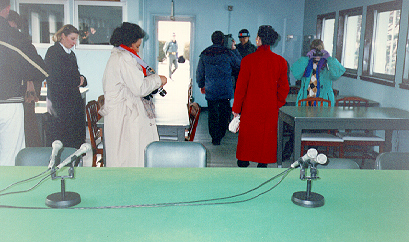 The negotiations between North and South take place in Panmunjom,
supposedly the most heavily armed military area in the world. It's
essentially a tiny army base, with the blue buildings belong to the UN,
gray buildings to North Korea. These high-level talks talks take place
in a blue building, but it straddles the demarcation line and has two
entrances: the North Koreans enter from their side and never have to
enter into the South, and vice versa. The conference table straddles the
line; exactly half is in each country. There are microphones on the
table (for translation), and the cords even run down the middle of the
table, neither in the North or in the South. (I stood in North Korea
to take this picture... the rest of my tour group is in South Korea.)
The negotiations between North and South take place in Panmunjom,
supposedly the most heavily armed military area in the world. It's
essentially a tiny army base, with the blue buildings belong to the UN,
gray buildings to North Korea. These high-level talks talks take place
in a blue building, but it straddles the demarcation line and has two
entrances: the North Koreans enter from their side and never have to
enter into the South, and vice versa. The conference table straddles the
line; exactly half is in each country. There are microphones on the
table (for translation), and the cords even run down the middle of the
table, neither in the North or in the South. (I stood in North Korea
to take this picture... the rest of my tour group is in South Korea.)
As our military guide escorted us through this area (we were
under the protection of a tank leading the way), we noticed the soldiers
from both sides standing at attention, staring each other down. Only 100
yards or so separated the opposing troops. The UN Soldiers were poised
with their bodies halfway behind their blue buildings; they were able to
partially protect themselves, while using half their body to keep an eye
on the enemy. The tension was real and apparent. This, perhaps, was
the most frightening thing I saw on the tour.
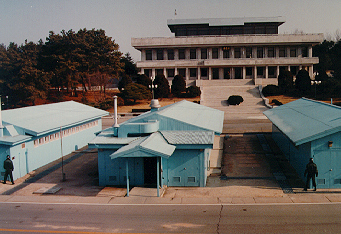
The large grey building is in North Korea. Although you can't see him in
this photo very well, there is a North Korean guard standing at the top
of the building's stairsteps...
The blue buildings are owned by the UN, and straddle the official line
between North & South Korea.
(There is actually a small cement 'rail' runnning along the ground, and
it intersects the buildings halfway along their length.)
There are UN Soldiers standing on the south side of these UN buildings,
watching the North Korean guard in the grey building, and protecting our
tour group.
Half their bodies are 'protected' by the building, while the other half
watches the North.
All the members of our tour lived to tell about our excursion (probably
due to the fine soldiers pictured above), and most of us had a lovely
American meal at the USO cafe upon our return. :)

 The negotiations between North and South take place in Panmunjom,
supposedly the most heavily armed military area in the world. It's
essentially a tiny army base, with the blue buildings belong to the UN,
gray buildings to North Korea. These high-level talks talks take place
in a blue building, but it straddles the demarcation line and has two
entrances: the North Koreans enter from their side and never have to
enter into the South, and vice versa. The conference table straddles the
line; exactly half is in each country. There are microphones on the
table (for translation), and the cords even run down the middle of the
table, neither in the North or in the South. (I stood in North Korea
to take this picture... the rest of my tour group is in South Korea.)
The negotiations between North and South take place in Panmunjom,
supposedly the most heavily armed military area in the world. It's
essentially a tiny army base, with the blue buildings belong to the UN,
gray buildings to North Korea. These high-level talks talks take place
in a blue building, but it straddles the demarcation line and has two
entrances: the North Koreans enter from their side and never have to
enter into the South, and vice versa. The conference table straddles the
line; exactly half is in each country. There are microphones on the
table (for translation), and the cords even run down the middle of the
table, neither in the North or in the South. (I stood in North Korea
to take this picture... the rest of my tour group is in South Korea.)

